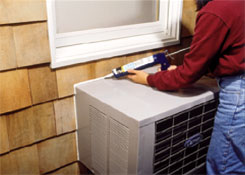window air conditioner

A window air conditioner, also known as a room air conditioner, is an appliance that cools a single room rather than an entire home or business. If they provide cooling only where they're needed, window air conditioners are less expensive to operate than central units, even though their efficiency is generally lower than that of central air conditioners.
Smaller window air conditioners – those drawing less than 7.5 amps of electricity – can be plugged into any 15- or 20-amp, 115-volt household circuit that is not shared with any other major appliances. Larger room air conditioners (those drawing more than 7.5 amps) need their own dedicated 115-volt circuit. The largest models require a dedicated 230-volt circuit.
Energy efficiency of window air conditioners
A window air conditioner's efficiency is measured by the energy efficiency ratio (EER). The EER is the ratio of the cooling capacity (in British thermal units per hour) to the power input (in watts). The higher the EER rating, the more efficient the air conditioner. National appliance standards require room air conditioners built after Jan. 1, 1990, to have an energy efficiency ratio (EER) of 8.0 or greater.
The Association of Home Appliance Manufacturers reports that the average EER of window air conditioners rose 47% from 1972 to 1991. If you own a 1970's-vintage room air conditioner with an EER of 5 and you replace it with a new one with an EER of 10, you will cut your air conditioning energy costs in half.
When buying a new window air conditioner, look for units with an EER of 10.0 or above. Check the EnergyGuide label for the unit, and also look for room air conditioners with the ENERGY STAR label.
Sizing and selecting a window air conditioner
The required cooling capacity for a window air conditioner depends on the size of the room being cooled: Window air conditioners generally have cooling capacities that range from 5,500 BTU per hour to 14,000 BTU per hour. A common rating term for air conditioning size is the "ton," which is 12,000 BTU per hour.
Proper sizing is very important for efficient air conditioning. A bigger unit is not necessarily better because a unit that is too large will not cool an area uniformly. A small unit running for an extended period operates more efficiently and is more effective at dehumidifying than a large unit that cycles on and off too frequently.
Based on size alone, an air conditioner generally needs 20 BTU for each square foot of living space. Other important factors to consider when selecting an air conditioner are room height, local climate, shading, and window size.
Verify that your home's electrical system can meet the unit's power requirements. Room units operate on 115-volt or 230-volt circuits. The standard household receptacle is a connection for a 115-volt branch circuit. Large room units rated at 115 volts may require a dedicated circuit and room units rated at 230 volts may require a special circuit.
If you are mounting your air conditioner near the corner of a room, look for a unit that can direct its airflow in the desired direction for your room layout. If you need to mount the air conditioner at the narrow end of a long room, then look for a fan control known as "Power Thrust" or "Super Thrust" that sends the cooled air farther into the room.
Other features to look for:
Installing and operating a window air conditioner
 |
A little planning before installing your air conditioner will save you energy and money. The unit should be level when installed, so that the inside drainage system and other mechanisms operate efficiently. If possible, install the unit in a shaded spot on your home's north or east side.
Direct sunshine on the unit's outdoor heat exchanger decreases efficiency by as much as 10%. You can plant trees and shrubs to shade the air conditioner, but do not block the airflow.
Don't place lamps or televisions near your air-conditioner's thermostat. The thermostat senses heat from these appliances, which can cause the air conditioner to run longer than necessary.
Set your air conditioner's thermostat as high as is comfortably possible in the summer. The less difference between the indoor and outdoor temperatures, the lower your overall cooling bill will be. Don't set your thermostat at a colder setting than normal when you turn on your air conditioner; it will not cool your home any faster and could result in excessive cooling and unnecessary expense.
Set the fan speed on high, except on very humid days. When humidity is high, set the fan speed on low for more comfort. The low speed on humid days will cool your home better and will remove more moisture from the air because of slower air movement through the cooling equipment.
Consider using an interior fan in conjunction with your window air conditioner to spread the cooled air more effectively through your home without greatly increasing electricity use.
